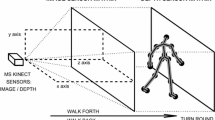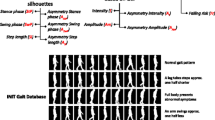Abstract
This paper presents a novel method of gait recognition that uses the image and depth sensors of the Microsoft (MS) Kinect to track the skeleton of a moving body and allows for simple human–machine interaction. While video sequences acquired by complex camera systems enable very precise data analyses and motion detection, much simpler technical devices can be used to analyze video frames with sufficient accuracy in many cases. The experimental part of this paper is devoted to gait data acquisition from 18 individuals with Parkinson’s disease and 18 healthy age-matched controls via the proposed MS Kinect graphical user interface. The methods designed for video frame data processing include the selection of gait segments and data filtering for the estimation of chosen gait characteristics. The proposed computational algorithms for the processing of the matrices acquired by the image and depth sensors were then used for spatial modeling of the moving bodies and the estimation of selected gait features. Normalized mean stride lengths were evaluated for the individuals with Parkinson’s disease and those in the control group and were determined to be 0.38 and 0.53 m, respectively. These mean stride lengths were then used as features for classification. The achieved accuracy was >90 %, which suggests the potential of the use of the image and depth sensors of the MS Kinect for these applications. Further potential increases in classification accuracy via additional biosensors and body features are also discussed.






Similar content being viewed by others
Explore related subjects
Discover the latest articles, news and stories from top researchers in related subjects.References
Brscic D, Kanda T, Ikeda T, Miyashita T (2013) Person tracking in large public spaces using 3-D range sensors. IEEE Trans Hum Mach Syst 43(6):522–534
Han J, Shao L, Xu D, Shotton J (2013) Enhanced computer vision with Microsoft Kinect sensor—a review. IEEE Trans Cybern 43(5):1318–1344
Procházka A, Vyšata O, Schätz M, Ťupa O, Yadollahi M, Vališ M (2014) The MS Kinect image and depth sensors use for gait features detection. In: IEEE international conference on image processing (ICIP)
Tupa O (2014) Multi-dimensional data modelling and analysis using MS Kinect. Master thesis, Institute of Chemical Technology in Prague
Ringer M, Lasenby J (2002) Multiple hypothesis tracking for automatic optical motion capture. Lecture Notes in Computer Science 2350, Springer-Verlag Berlin, pp 524–536
Lasenby J, Stevenson A (2000) Using geometric algebra for optical motion capture. In: Bayro-Corrochano E, Sobcyzk G (eds) Applied Clifford algebras in computer science and engineering. Birkhauser, Boston
Procházka A, Kubíček M, Pavelka A (2006) Multicamera systems in the moving body recognition. In: IEEE 48th international symposium on ELMAR
Fortino G, Giannantonio R, Gravina R, Kuryloski P, Jafari R (2013) Enabling effective programming and flexible management of efficient body sensor network applications. IEEE Trans Hum Mach Syst 43(1):115–133
Camplani M, Mantecon T, Salgado L (2013) Depth-color fusion strategy for 3-D scene modeling with kinect. IEEE Trans Cybern 43(6):1560–1571
Lu J, Tan YP (2013) Ordinary preserving manifold analysis for human age and head pose estimation. IEEE Trans Hum Mach Syst 43(2):249–258
Yanik P, Manganelli J, Merino J, Threatt A, Brooks J, Green K, Walker I (2014) A gesture learning interface for simulated robot path shaping with a human teacher. IEEE Trans Hum Mach Syst 44(1):41–54
Li Y (2012) Multi-scenario gesture recognition using kinect. In: 17th international conference on computer games, pp 126–130
Strbac M, Markovic M, Popovic DB (2012) Kinect in neurorehabilitation: computer vision system for real time hand and object detection and distance estimation. In: IEEE 11th symposium on neural network application in electrical engineering (NEUREL 2012), USA, pp 127–132
Milovanovic M, Minovic M, Starkevic D (2012) New gait recognition method using Kinect stick figure and CBIR. In: Proceedings of the telecommunications forum (TELFOR), pp 1323–1326
Shum H, Ho E, Jiang Y, Takagi S (2013) Real-time posture reconstruction for Microsoft Kinect. IEEE Trans Cybern 43(5):1357–1369
Choudry M, Beach T, Callaghan J, Kulic D (2013) A stochastic framework for movement strategy identification and analysis. IEEE Trans Hum Mach Syst 43(3):314–327
Zhang C, Xu J, Xi N, Jia Y, Li W (2012) Development of an omni-directional 3D camera for robot navigation. In: 2012 IEEE/ASME international conference on advanced intelligent mechatronics, USA, pp 262–267
Wang Y, Yang C, Wu X, Xu S, Li H (2012) Kinect based dynamic hand gesture recognition algorithm research. In: 4th international conference on intelligent human–machine systems and cybernetics, pp 274–279
Machida E, Cao M, Murao T, Hashimoto H (2012) Human motion tracking of mobile robot with Kinect 3D sensor. In: SICE annual conference, Akita University, Japan, pp 2207–2211
Clark RA, Pua YH, Fortin K, Ritchie C, Webster KE, Denehy L, Bryant AL (2012) Validity of the Microsoft Kinect for assessment of postural control. Gait Posture 36:372–377
Gabel M, Renshaw E, Schuster A, Gilad-Bachrach R (2012) Full body gait analysis with Kinect. In: International conference of the IEEE engineering in medicine and biology
Preis J, Kessel M, Werner M, Linnhoff-Popien C (2012) Gait recognition with Kinect. In: 1st international workshop on kinect in pervasive computing, pp P1–P4
Weber I, Koch J, Meskemper J, Friedl K, Heinrich K, Hartmann U (2012) Is the MS Kinect suitable for motion analysis? Biomed Eng 57(8):664
Lee S, Shin S (2014) Gait signal analysis with similarity measure. Sci World J 2014:1–8
Gelb D, Oliver E, Gilman S (2011) Diagnostic criteria for Parkinson disease. JAMA Neurol 56(1):33–39
Venkat I, De Wilde P (2011) Robust gait recognition by learning and exploiting sub-gait characteristics. Int J Comput Vis 91(1):7–23
Yogev G, Giladi N, Peretz C, Springer C, Simon ES, Hausdorff JM (2005) Dual tasking, gait rhythmicity, and Parkinson’s disease: which aspects of gait are attention demanding? Eur J Neurosci 22(5):1248–1256
Zhang Z (2012) Accuracy and resolution of Kinect depth data for indoor mapping applications. IEEE Multimed 19(2):4–10
Qin S, Zhu X, Yang Y (2014) Real-time hand gesture recognition from depth images using convex shape decomposition method. J Signal Process Syst 74:47–58
Image Acquisition Toolbox: User's Guide (2013) The MathWorks, Natick
Khoshelham K, Elberink SO (2012) Accuracy and resolution of Kinect depth data for indoor mapping applications. Sensors 12:1437–1454
Obdrzalek S, Kurillo G, Ofli F, Bajcsy R, Seto E, Jimison H, Pavel M (2012) Accuracy and robustness of Kinect pose estimation in the context of coaching of elderly population. In: 34th annual international conference of the IEEE EMBS, IEEE, USA, pp 1188–1193
Smisek J, Jancosek M, Pajdla T (2012) 3D with kinect. In: IEEE international conference on computer vision, IEEE, USA, pp 1154–1160
Essmaeel K, Gallo L, Damiani E, De Pietro G, Dipanda A (2012) Temporal denoising of Kinect depth data. In: Eighth international conference on signal image technology and internet based systems. IEEE Computer Society, IEEE, USA, pp 47–52
Fawcett T (2006) An introduction to ROC analysis. Pattern Recognit Lett 27:861–874
BenAbdelkader C, Cutler R, Davis L (2002) Person identification using automatic height and stride estimation. In: Proceedings of the 16th international conference on pattern recognition, vol 4, pp 377–380
Munsell B, Temlyakov A, Qu C, Wang S, (2012) Person identification using full-body motion and anthropometric biometrics from Kinect videos. In: ECCV 2012 ARTEMIS workshop
Dockstader S, Bergkessel K, Tekalp A (2002) Feature extraction for the analysis of gait and human motion. In: Proceedings of the 16th international conference on pattern recognition, vol 1, pp 5–8
Vysata O, Schatz M, Valis M, Prochazka A, Simunek L (2013) Quantitative gait analysis in Parkinson’s disease using MS Kinect: entropy and fractal dimension. J Neurol Sci 333(Suppl. 1):e67
Chen Y, Cho C, Lin S, Lai H, Lo Y, Chen S, Chang Y, Huang W, Chen C, Jaw F, Tsang S, Tsai S (2012) A vision-based regression model to evaluate Parkinsonian gait from monocular image sequences. Expert Syst Appl 39:520–526
Muro-de-la-Herran A, Garcia-Zapirain B, Mendez-Zorrilla A (2014) Gait analysis methods: an overview of wearable and non-wearable systems, highlighting clinical applications. Sensors 14:3362–3394
Galna B, Barry G, Jackson D, Mhiripiri D, Olivier P, Rochester L (2014) Accuracy of the Microsoft Kinect sensor for measuring movement in people with Parkinson’s disease. Gait Posture 39:1062–1068
Acknowledgments
Authors would like to thank all patients who signed the informed consent to participate in the project with all the procedures approved by the local ethics committee as stipulated by the Helsinki Declaration. All data were kindly provided by the Movement Disorders Center of the Faculty Hospital in Hradec Králové, Czech Republic.
Author information
Authors and Affiliations
Corresponding author
Rights and permissions
About this article
Cite this article
Procházka, A., Vyšata, O., Vališ, M. et al. Use of the image and depth sensors of the Microsoft Kinect for the detection of gait disorders. Neural Comput & Applic 26, 1621–1629 (2015). https://doi.org/10.1007/s00521-015-1827-x
Received:
Accepted:
Published:
Issue Date:
DOI: https://doi.org/10.1007/s00521-015-1827-x




